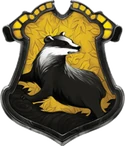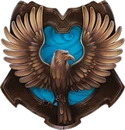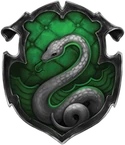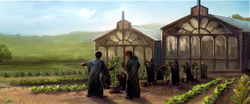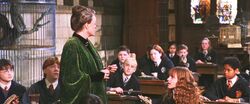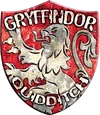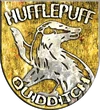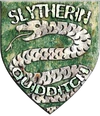
|
Warning!
At least some content in this article is derived from information featured in: Harry Potter: Hogwarts Mystery & Harry Potter: Puzzles & Spells & Harry Potter: Magic Awakened & Hogwarts Legacy & Harry Potter: Quidditch Champions. |
- "The finest school of witchcraft and wizardry in the world."
- — Rubeus Hagrid's praising of Hogwarts[src]
Hogwarts School of Witchcraft and Wizardry, often shortened to Hogwarts, was the British wizarding school located in the Scottish Highlands.[6][7] Any magical children residing in Great Britain or Ireland who had reached the age of eleven by the start of the incoming term were accepted as students.[8][9] It was a state-owned school, funded by the British Ministry of Magic.[10]
The precise location of the school could never be uncovered because it was rendered Unplottable. To Muggles, the school appeared to be an old, abandoned castle. Similarly, most wizarding schools' locations were protected in order to protect the students and schools themselves from any harm.[4]
Established around the 10th century, Hogwarts was considered to be one of the finest magical institutions in the wizarding world, though other notable schools included Beauxbatons Academy of Magic in France, the Durmstrang Institute implied to be in northern Europe, and Ilvermorny School of Witchcraft and Wizardry in the United States.[4]
British and Irish children with magical abilities were enrolled at birth by the Quill of Acceptance and Book of Admittance,[11] and acceptance was confirmed by owl post at age eleven. However, if the child in question was a Muggle-born or raised by Muggles, like Harry Potter, with no knowledge of the wizarding world, a special messenger from the school visited the child and his or her family in order to inform them of their magical heritage and the existence of the wizarding world.[12] It was possible for students to transfer to the school as well.
The school's motto was Draco Dormiens Nunquam Titillandus (Draco Dormiens Nvnqvam Titillandvs), which, translated from Latin, means "Never tickle a sleeping dragon".
Description
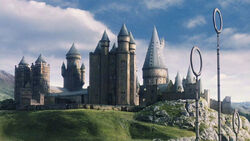
View of the Hogwarts Castle and baskets of the Quidditch pitch
Hogwarts School, located somewhere in the Highlands of Scotland, consisted of the large Hogwarts Castle and extensive school grounds surrounding it, which included sloping lawns, flowerbeds, vegetable patches, as well as a loch (called the Black Lake), a large dense forest (called the Forbidden Forest), several greenhouses and other outbuildings, and a full-size Quidditch Pitch. One of the castle's towers held an owlery, which housed all the owls owned by the school and by students.
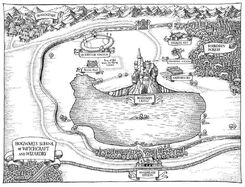
A map of the Hogwarts grounds and surrounding areas
The castle was set upon huge rocks above the Black Lake. Its three highest towers were the Astronomy, Ravenclaw, and Gryffindor Towers. The castle's 142 staircases were known to change position. The castle was known for its many updates and changes in layout throughout the years. It should be noted that some rooms in the school tended to "move around", as did the steps on the Grand Staircase. Albus Dumbledore once noted that even he did not know all of Hogwarts' secrets. The castle had been around for centuries, and consequently had a long history of ancient magic.
The school had numerous ancient charms and spells on and around it to safeguard it from danger. In addition to the fact that there were enchantments that prevented people from entering by stealth, it was also impossible for a Muggle to see it, as the school was bewitched so that when they looked at it, all they saw were some old ruins and several warnings of danger. Witches and wizards could not Apparate or Disapparate in Hogwarts grounds, except for when the Headmaster lifted the enchantment, whether only in certain areas or for the entire campus, so as to make the school less vulnerable when it served the headmaster to allow Apparition. Electricity and electronic devices were not found at Hogwarts. Due to the high levels of magic, Muggle substitutes for magic, such as computers, radar and electricity, "went haywire" around Hogwarts. Radios, however, were an exception as they were not powered by electricity, but by magic.
History
Founding
- "We'll teach just those whose ancestry's purest."
- — Professor Slytherin's opinion on the running of Hogwarts[src]
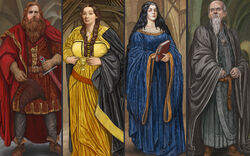
The four founders of Hogwarts
Hogwarts was founded around 990 A.D. by four of the greatest wizards and witches of the age: Godric Gryffindor, Helga Hufflepuff, Rowena Ravenclaw, and Salazar Slytherin.[13] They each represented an aspect of personality that they wanted to bring out in new students.[14] They also placed certain protective enchantments in place to ensure the well-being of their students, for which reason the castle and grounds had both always been protected with Anti-Apparition Charms.[7] Around the same time, the four founders employed the school's first caretaker, Hankerton Humble, who would often clash with Peeves, the resident poltergeist, which he would have in common with every successive caretaker after him in the history of Hogwarts.[15]
Although the four founders cooperated well for a time, shortly after founding the school, Slytherin had a falling out with the other founders about blood purity, and wanted to admit only pure-blood students. He felt only pure-blooded students deserved to learn magic, and those of other ancestry such as Muggle-borns and half-bloods were unworthy. The other three founders all disagreed, especially Gryffindor. Slytherin left the school, but not before secretly building the Chamber of Secrets. He foretold that only his own heir would be able to open it once they arrived at the school, and the heir would unleash a murderous basilisk living inside to purge the school of all Muggle-born students.[13] Despite the fact that the founders of Hogwarts were effectively in charge of the school during their time, none of them held the title of Headmaster or Headmistress of the school,[16] as that was only used sometime after Slytherin's departure, and held by another wizard, who was the first person to be entrusted the stewardship of Hogwarts Castle and the surrounding grounds after the three remaining founders passed away.[17]
The first student class to graduate from the school were immortalised in a portrait that would continue to hang in the school for over 1000 years.[18]
Early history
According to the eventual Gryffindor House ghost, Sir Nicholas de Mimsy-Porpington, because Hogwarts Castle was always intended as a safe place, the school had historically shouldered the responsibility of protecting "dangerous things" from falling into the wrong hands, and carrying the burden of the job remarkably well despite the fact that subsequent heads of the school and members of the faculty came to recognise how it compromised the security of the castle.[19] Indeed: Albus Dumbledore would reiterate this truth to Harry Potter years later during their private lessons into the history of Lord Voldemort, when the then Headmaster described Hogwarts Castle as "a stronghold of ancient magic", and explained that his refusal to employ him as a teacher stemmed in part from the suspicion that the Dark wizard would unravel more of its mysteries and take advantage of untapped stores of magic within the school for his own, nefarious purposes.[20]
About three hundred years after the school was founded, the Triwizard Tournament was established as an interscholastic competition between three of the most prestigious magical schools in Europe: Hogwarts, Beauxbatons (France) and Durmstrang (an unknown Northern European country). This tournament was considered the best way for wizards and witches of different nationalities to meet and socialise. The tournament continued for six centuries, until the death toll became too high. The tournament was discontinued until 1994.[21]
At some point in the 13th century, following the invention of Floo powder by Ignatia Wildsmith and the subsequent development of the Floo Network, a long line of Heads of the school refused to permit the school's fireplaces to be accessible this way, for fear of the castle's security could be breached.[22] However, by the 19th century, a network of Floo Flames had been set up that allowed students to quickly travel both within the castle, or between the inside and outside.[23]
Unrest with ancient magic
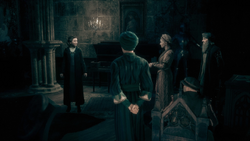
Isidora Morganach meeting the Keepers
In the Tudor period, four professors of the school, Percival Rackham, Charles Rookwood, Niamh Fitzgerald and San Bakar, formed the Keepers dedicated to keeping the secrets of ancient magic away from dangerous forces.[24] They welcomed Isidora Morganach to the school as a new student who started unconventionally as a fifth-year and learnt that she had the rare abilities of detecting and harnessing ancient magic.[25]
Professor Rackham, a wizard with similar abilities, mentored her to wield and master this power, but after becoming the Defence Against the Dark Arts professor,[26] Isidora ultimately went down a different path in which she used her abilities to extract pain from others,[27] sometimes even without their permission,[28] till the point where she ridded her father of all emotions, creating an ancient magic repository stored in the Keepers' Caverns. The Keepers disapproved of her actions and faced her in a duel, ending in Professor Bakar eliminating Isidora with the Killing Curse.[29] They then constructed a path leading to their portraits in the Map Chamber which might only be followed by another with abilities of ancient magic, and set up trials around the castle to make sure that their successor would be worthy of the power and make the right choices.[24]

The second-floor girls' bathroom services as the entrance to the Chamber
During the 1700s, there was a proposal to install an elaborate plumbing system in the castle. This threatened the secrecy of the Chamber of Secrets, forcing Corvinus Gaunt, a Slytherin student, descendant of Salazar Slytherin and Parselmouth, to protect the entrance to the Chamber by having it concealed behind plumbing fixtures and sinks in second-floor girls' bathroom, so only future heirs of Slytherin would know how to open the Chamber.[30]
In 1876, then caretaker Rancorous Carpe made a spectacularly unsuccessful attempt to rid the school of Peeves by trying to bait him into a trap involving a wide variety of Muggle weapons and a vast, enchanted bell jar reinforced with various Containment Charms, which resulted in the evacuation of the castle and a three-day standoff between the vengeful poltergeist and then Headmistress Eupraxia Mole. In the end, the good professor agreed to sign a contract promising him additional privileges, including weekly swim in the boys' toilets on the ground floor, pickings of stale bread from the kitchen for throwing purposes and a new hat — to be custom-made by the Parisian witch Madame Bonhabille. After this, Carpe went into early retirement for "health reasons"[31] and was succeeded by Gladwin Moon.[32] The faculty didn't attempt to evict the poltergeist again,[31] though he still had a strained relationship with them, notably Madam Agnes Scribner, the librarian, who had Peeves as her "sworn nemesis",[33] and Professor Phineas Nigellus Black, who at some point had taken over as the least popular Headmaster the school had seen[34] and was often tormented by Peeves.[35]
In 1889, Mudiwa Onai travelled from Uagadou to Hogwarts to teach Divination, bringing her daughter Natsai Onai to the school.[36] The spring of 1890 saw the injury of a pure-blood[37] student during the Quidditch final, leading to Professor Black banning Quidditch in the next school year.[38]
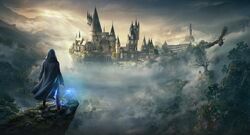
The new fifth-year student at Hogwarts
That year, a new student would arrive at the school who, like Isidora Morganach, would begin as a fifth-year. Professor Black and the Deputy Headmistress Matilda Weasley worked with the Ministry to devise a plan for the student to ensure their success.[38] They were personally mentored by Professor Eleazar Fig to hone their magical skills, and, through their unexpected detour while travelling to Hogwarts, showed abilities of ancient magic.[39] After enrolling, they successfully reached the Map Chamber,[40] whereupon they completed all four of the Keepers' trials.[26][27][28][29] Their time at Hogwarts coincided with the goblin Ranrok's pursuit of the power within the ancient magic repositories,[41] during which an uneasy alliance was formed between Ranrok and the Dark wizard Victor Rookwood.[27]
After vanquishing Rookwood,[42] the student faced Ranrok in a final battle in the Keepers' Caverns aided by the faculty, and ended his rebellion. However, it also saw the death of Professor Fig, for whom the school held a memorial ceremony.[43] During this time, the student also joined their classmates Natsai Onai and Poppy Sweeting in taking down Theophilus Harlow,[44] Rookwood's right-hand man,[45] and thwarting the plots of poachers,[46] respectively. The student also helped Sebastian Sallow with finding a cure for his sister Anne Sallow, which ended in failure.[47]
Prelude to the war
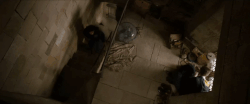
Leta finding Newt in a cupboard
In the 1910s, Leta Lestrange was bullied at Hogwarts due to the gossip about her being an unwanted child and the tragic death of her half-brother. She encountered Newt Scamander while searching for a place to hide from her pursuers, whom she had used the dark charm Oscausi on in retaliation for their malicious gossip. Newt and Leta developed a remarkably close bond, spending much time together over the holidays caring for an injured baby raven.[48]
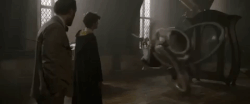
Newt facing his greatest fear, an office job
At one point, when Albus Dumbledore was teaching students how to defend against Boggarts in Defence Against the Dark Arts class, Newt was asked to step forward and was revealed that he was scared of ending up stuck with a tedious office job. Leta went soon after and showed that her boggart was her half-brother drowning to death. Leta was later comforted by Newt near the Great Lake, when she was upset by her own Boggart. He show her one of the Bowtruckles he had befriended on the school grounds, because he was the only one they would not hide from.[48]
Global Wizarding War
- "Why leave Hogwarts when the world outside is burning?"
- — Anton Vogel about Albus Dumbledore staying in the castle during the Global Wizarding War[src]
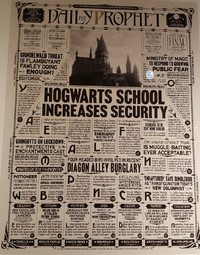
The 29 November 1926 issue of the Daily Prophet
On 29 November 1926, the Daily Prophet reported that security had to be increased at Hogwarts in response to the growing threat of Gellert Grindelwald's impact on the Global Wizarding War. Measures included Headmaster Armando Dippet holding an emergency meeting with worried parents and students being sent home early.[49]
Torquil Travers and Theseus Scamander came here to seek out the current Defence Against the Dark Arts teacher, Albus Dumbledore and talk to him about Grindelwald and his plans. Leta soon after walks around Hogwarts and reminisces on the past. Dumbledore finds her and they talk about their shared trauma of losing their siblings.[48]
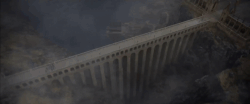
Newt Scamander coming to talk to Dumbledore
Newton Scamander, Porpentina Goldstein, Theseus Scamander, Torquil Travers, Rudolph Spielman, Nagini, Jacob Kowalski, Yusuf Kama, and an unidentified Ministry man came back to talk to Albus Dumbledore about Grindelwald's rally and the blood pact Grindelwald made with Dumbledore.[48]
Even during the Global Wizarding War, Hogwarts was kept open and live, running and allowing students to attend.[50]
First Chamber of Secrets opening
- "Of course, it was fifty years ago, so it was before his time, but he knows all about it, and he says that it was all kept quiet and it'll look suspicious if I know too much about it. But I know one thing — last time the Chamber of Secrets was opened, a Mudblood died. So I bet it's a matter of time before one of them's killed this time.... I hope it's Granger"
- — Draco Malfoy discussing the first opening of the Chamber of Secrets[src]
The existence of the school was threatened twice when the Chamber of Secrets was opened. The first time it was opened was in 1942, when Slytherin house pupil Tom Riddle, a direct descendant of Salazar Slytherin and the man who would become Lord Voldemort, opened the Chamber in his fifth year.[51]
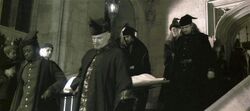
Myrtle's body being removed from school grounds
When a girl named Myrtle Warren was killed in 1943, the Ministry of Magic threatened to close the school. As Riddle spent his time away from Hogwarts in a Muggle orphanage, he did not want the school closed. His request to remain in school over the holidays was denied due to the situation he created. Upset with himself, he framed Rubeus Hagrid, and although Albus Dumbledore still suspected Riddle, Hagrid was expelled, and Riddle got off without punishment. He, however would leave a cursed diary which would allow him to possess anyone who used it in order to reopen the Chamber and continue the heinous work. It was only after the 1992-1993 reopening that Riddle's crime was exposed and Hagrid was exonerated.[51]
First Wizarding War
- Jacob's sibling: "Who created the Cursed Vaults? And why?"
- Albus Dumbledore: "There are many theories. Some say they were crafted by one of the Founders, others say they were built by a paranoid Headmaster... As far as why, most of the speculation is too dangerous and implausible to indulge until we know the truth."
- — Jacob's sibling talking to Albus Dumbledore about the Cursed Vaults[src]
Throughout the entirety of the First Wizarding War, which lasted for eleven long years and caused much distress among the students, Hogwarts Castle was perhaps the only safe haven in wizarding Britain, due to the presence of Albus Dumbledore. Dumbledore had risen to the post of Headmaster, and was the only one whom Voldemort was ever afraid of.[52]
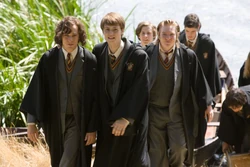
The Marauders in the 1970s
During that time, Severus Snape, Remus Lupin, Sirius Black, Peter Pettigrew, as well as Lily Potter and James Potter attended Hogwarts and four of them were part of the infamous Marauders, who often bullied Snape frequently,[53] until they graduated in 1978.
While war waged outside the ancient walls of the school and it remained safe from Dark Forces outside the castle, the existence of ancient threats hidden deep within it began to stir when a student by the name of Jacob became intrigued with and began to search for the fabled Cursed Vaults, five secret rooms of ambiguous origins somewhere within the castle said to house ancient magical treasures older even than the school itself.[citation needed]
Jacob grew increasingly obsessed with his quest to prove the existence of the Cursed Vaults throughout his school career and broke several school rules in his effort to locate them. The situation escalated further as when the pupil finally found it, he examined the outer chamber leading to the vault and, as a result of tampering with magic he did not understand, he inadvertently unleashed a curse that threatened to encase the entire castle in ice, injuring several students in the process.[citation needed]
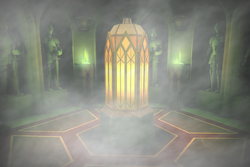
A Cursed Vault, hidden within the castle and its grounds
By that point, Jacob's quests for the vaults were no secret. Rumours began spreading among the student body that he unleashed several curses upon the school, and even was cursed himself and that he eventually went mad. Ultimately, however, Jacob managed to break into the vault itself, causing the ice to vanish. Despite his part in ending the threat, however, he was found to have endangered the school, as he unleashed the threat in the first place. Jacob's resultant expulsion from Hogwarts was covered in the Daily Prophet.[54]
With the cursed ice gone from the halls of Hogwarts and his students once more safe from it, Dumbledore and the rest of the school staff did their best to dim the rumours that Jacob had actually located one of the vaults, treating it as an isolated incident that had more to do with Jacob's search for the Cursed Vaults rather than the vaults themselves. They hoped to discourage others from looking for them and maintain the common view that they were just a myth. This worked so effectively that while people still spoke of it a long time afterwards, no one, not even Jacob's own mother, believed that the Cursed Vaults actually existed.[citation needed]
By the end of the 1970s, Lord Voldemort's ascendancy was almost complete. While the Ministry of Magic did their best to both put up a fight and keep wizardkind a secret, a true resistance to him was being concentrated in the underground organisation founded by Dumbledore himself called the Order of the Phoenix. Several former students at the school went on to join the order.[citation needed]
On Hallowe'en of the 1981–1982 school year, news would have reached the school of the fall of Lord Voldemort and his failed attempt at murdering the infant Harry Potter, after which students and staff alike would have celebrated the fall of the Dark Lord.[citation needed]
Race for the Cursed Vaults
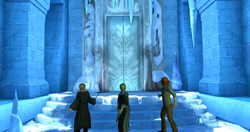
Jacob's sibling and their friends breaking into the Vault of Ice
The effects of the Cursed Vaults resurfaced around Hogwarts after the end of the war. It first started with the cursed ice reappearing in Hogwarts castle during the 1984–1985 school year. By that time, Jacob's younger sibling had enrolled, and it took two years for they and their friends to locate and break into the Vault of Ice and stop the ice from further spreading.[55] The rest of the Cursed Vaults had subsequently all been tampered with, contaminating the school respectively with Boggarts,[56] the sleepwalking curse[57] and the portrait curse,[58] but thanks to Jacob's sibling and their continually growing circle of friends, the next three Vaults were successfully infiltrated in three consecutive school years.[59][60][61]
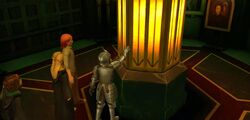
Jacob's sibling opening the centre column in the Buried Vault after defeating Patricia Rakepick
During this time, it was gradually revealed to Jacob's sibling and their friends that a secret dark organisation known as R existed and had also been trying to find the Cursed Vaults for the supposed treasures. At the start of Jacob's sibling's fourth year, the 1987–1988 school year, Patricia Rakepick arrived at Hogwarts apparently to help Albus Dumbledore deal with the Cursed Vaults,[57] while in fact being a Dark witch from R who sought to continue her unfinished business with the Vaults. She became the Defence Against the Dark Arts professor the next year and trained several students, including Jacob's sibling, to be her curse-breaking assistants. Arriving again outside the Buried Vault, she revealed her true nature to the students and attempted to go in before them, but was magically choked by Jacob's sibling and fled.[61]
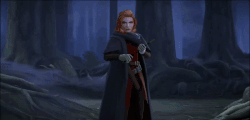
Patricia Rakepick murdering Rowan Khanna
Rakepick's ability to teach students to defend against the Dark Arts, ironically, turned out to have been a lot more competent than the professor who succeeded her in the next school year. With Dumbledore's permission, the fresh graduate Bill Weasley returned to the school to teach this subject after regular classes.[62] During the school year, yet another curse spread around Hogwarts, continuing to Petrify students, indicating the activity of the final Cursed Vault.[63] While working towards investigating R, the students encountered Rakepick in the Forest Grove, who attempted to kill Ben Copper, leading to the sacrifice of Rowan Khanna.[64]
The school staff held a memorial ceremony and suspended the lessons,[65] and the tragedy prompted the vengeful Jacob's sibling, Ben Copper and Merula Snyde to form a secret organisation of their own, the Circle of Khanna, to fight R and race them in locating the final Cursed Vault.[66] It was found to be under the Great Lake, and they had a final showdown with Rakepick outside. She was once again defeated before Jacob's sibling decided to seal the Vault for good to prevent the ancient statue curse from being unleashed again.[67]
Harry Potter enrolled
Protecting the Philosopher's Stone
- Albus Dumbledore: "And finally, I must tell you that this year, the third-floor corridor on the right-hand side is out of bounds to everyone who does not wish to die a very painful death."
- Harry Potter: "He's not serious?"
- Percy Weasley: "Must be. It's odd, because he usually gives us a reason why we're not allowed to go somewhere — the forest's full of dangerous beasts, everyone knows that. I do think he might have told us prefects, at least."
- — Albus Dumbledore announcing rules for the 1991–1992 school year[src]
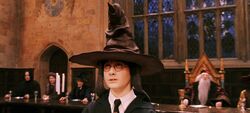
Famous Harry Potter being Sorted into Gryffindor
On 1 September 1991, Harry Potter began his career as a student at Hogwarts. Already famous for being believed to be responsible for vanquishing Lord Voldemort at the age of one, he soon began, with the help of his friends Ron Weasley and Hermione Granger, to unravel the secret of the Philosopher's Stone being kept at the school. Harry discovered that the Defence Against the Dark Arts Professor, Quirinus Quirrell, was a host body for the barely-alive Voldemort, who wanted to use the Stone to restore himself back to his former glory and gain everlasting life.[1]

Harry preventing Voldemort from acquiring the Philosopher's Stone
Harry, Ron, and Hermione suffered a series of difficult challenges down in the Underground Chambers, in an attempt to stop the Philosopher's Stone being stolen by Severus Snape. The three believed Snape was trying to steal the stone, when in reality, Quirrell was. Harry discovered Quirrell in the chambers and was able to defeat him, thwarting Voldemort in his attempt to get the Stone and restoring his body. Harry managed this after realising that Quirrell's skin burned whenever he made contact with Harry. Dumbledore stated that Lily's self sacrifice left a mark of love in Harry and that Quirrell was so full of hatred, greed, and ambition that he could not bear to touch a person marked by something so good.[1]
Reopening of the Chamber of Secrets
- "THE CHAMBER OF SECRETS HAS BEEN OPENED. ENEMIES OF THE HEIR, BEWARE."
- — A message from the Heir of Slytherin[src]

Ginny Weasley's attack on Mrs Norris and first blood-written message on the wall
In 1992, the Chamber of Secrets was re-opened by Ron's younger sister Ginny, under the influence of Tom Riddle's diary. The diary allowed Riddle's memory to possess Ginny and act through her to open the Chamber for a second time. She left threatening messages on the school walls twice, which were known as the Writing on the Wall. Several students were Petrified due to meeting the Serpent of Slytherin's gaze indirectly. Quidditch matches were largely cancelled. Towards the end of the school year, the situation at the school was so severe that it was possible for the school to be shut down completely.[51]
Desiring to see Lord Voldemort return to power, Lucius Malfoy had slipped the diary into her bundle of school books, taking advantage of her ignorance that it was a Horcrux. His ulterior motive was to ruin the reputations of several great wizards, including Dumbledore and the Weasley children's father Arthur Weasley, the latter of whom played a big role in the enactment of the Muggle Protection Act. However, Harry discovered the truth and destroyed the diary and the Basilisk, thus bringing an end to these dark plots.[51]
Sirius Black escaped
- "As you will all be aware after their search of the Hogwarts Express, our school is presently playing host to some of the Dementors of Azkaban, who are here on Ministry of Magic business. They are stationed at every entrance to the grounds, and while they are with us, I must make it plain that nobody is to leave school without permission."
- — Albus Dumbledore announcing the presence of Dementors at Hogwarts in 1993[src]
In 1993, Harry's notorious godfather Sirius Black escaped from Azkaban. Sirius had been convicted of murdering twelve Muggles and Peter Pettigrew with the Blasting Curse. He also betrayed James, Lily, and Harry Potter's whereabouts to Voldemort in his duty as their Secret-Keeper. Because of the charges against him, he spent twelve years in a high-security cell in Azkaban. The Ministry of Magic also believed that Black was after Harry, as they heard Black murmur "he's at Hogwarts" in his sleep. As a result, Black was thought to believe that killing Harry would bring Voldemort back to full power.[68]

Sirius Black's attack on the Fat Lady's portrait
Black broke into the school twice: one time almost ripping the Fat Lady to shreds, and another time getting close to Ron's "rat", Scabbers. During the second break-in, Ron awoke, which resulted in him screaming in fright, as Black loomed over him with a knife. His screams woke the whole tower and alerted McGonagall to the incident. After this incident, security measures were further heightened. Harry, Ron, and Hermione met Black in the Shrieking Shack, along with Remus Lupin. Lupin had been a friend of Black as well as Harry's parents and Pettigrew during the time they attended Hogwarts as a students.[68]
Black revealed the truth to them. He was innocent, and it was Pettigrew who had done the things Sirius had been convicted of. To frame Sirius, he had chopped off one of his fingers as a red herring, turned into his Animagus form (the rat, Scabbers), and scurried off. Sirius had come back to kill Pettigrew, and now that Lupin had heard his story, he believed him and set out to help.[68]

Hermione Granger and Harry Potter saving Buckbeak and Sirius Black
However, Harry persuaded them to give Pettigrew to the Ministry and let the Dementors have him. As they took Pettigrew back to the castle, Pettigrew escaped and returned to Voldemort to help him return to power. With the use of a time-turner, Harry and Hermione later helped Sirius escape on Buckbeak the Hippogriff while Ron was in the Hospital Wing, saving both Sirius' and Buckbeak's lives.[68]
The Triwizard Tournament revived
- "As I was saying, we are to have the honour of hosting a very exciting event over the coming months, an event that has not been held for over a century. It is my very great pleasure to inform you that the Triwizard Tournament will be taking place at Hogwarts this year."
- — Albus Dumbledore introducing the Triwizard Tournament in 1994[src]
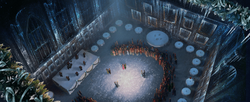
In 1994, Hogwarts played host to the infamous Triwizard Tournament, this time with more powerful safety measures in place. It had been many years since the last tournament had been held, but in the light of the advent of advanced safety measures, the tournament was deemed "safe". However, more dark plots were being hatched. Barty Crouch Jnr, disguised as Alastor "Mad-Eye" Moody, managed to enter Harry in the Tournament by putting his name in the Goblet of Fire under the name of a fourth school, which ensured he would be chosen by the Goblet.[21]
Harry's forced involvement in this plot caused him great misery at Hogwarts, as the representatives for Beauxbatons and Durmstrang, as well as many Hogwarts students, believed he hoodwinked the goblet and entered himself in the tournament. It was because of Crouch Jnr and his influence over certain house-elves that Harry ended up surviving until the end of the tournament and reaching the goal of the Third Task, along with fellow Hogwarts student Cedric Diggory. On Voldemort's orders, Diggory was killed by Pettigrew, and Harry was surrounded by Death Eaters in Little Hangleton graveyard. Voldemort was brought back to his physical form using Harry's blood.[21]
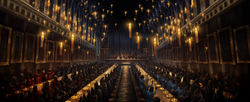
Voldemort attempted to torture and humiliate Harry by means of the Unforgivable Curses. He used the Cruciatus Curse twice on Harry and the Imperius Curse once; Harry was able to resist the latter. Harry escaped and succeeded in alerting all of Voldemort's enemies, Dumbledore in particular, that he had returned. Dumbledore reestablished the Order of the Phoenix one hour after he was alerted. However, many, including Minister for Magic Cornelius Fudge, chose not to believe him.[21]
Ministry takeover
- "We have had two changes in staffing this year. We are very pleased to welcome back Professor Grubbly-Plank, who will be taking Care of Magical Creatures lessons; we are also delighted to introduce Professor Umbridge, our new Defence Against the Dark Arts teacher."
- — Albus Dumbledore announcing teaching changes at the school in 1995[src]
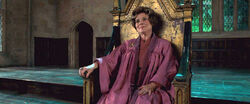
Umbridge as the Hogwarts High-Inquisitor
Hogwarts was further threatened when the Ministry of Magic began implementing "Educational Decrees" in 1995, as part of a conspiracy to discredit and ruin Dumbledore and Harry. Dolores Umbridge, the new Defence Against the Dark Arts teacher and Minister Fudge's Undersecretary, was the centre of this plan.
By way of these Educational Decrees, she slowly took control of Hogwarts, eventually replacing Dumbledore as Headmistress. However, it was through the cunning of Hermione and the other members of Dumbledore's Army, which was founded by her, Ron, and Harry, that Umbridge was overthrown. The Ministry had no choice but to accept that Voldemort had returned. Umbridge was then removed from Hogwarts and Dumbledore was reinstated.[69]
The Headmaster eliminated
- "The lightning-struck tower. Calamity. Disaster. Coming nearer all the time."
- — Professor Trelawney before the battle commences[src]
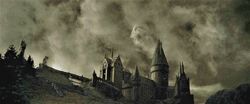
The Dark Mark above the Astronomy Tower
Through the 1996–1997 school year, the new Minister for Magic Rufus Scrimgeour ordered Aurors to guard Hogwarts for protection from Dark forces, along with the castle's defences being fortified in many ways. In 1997, Hogwarts was attacked by a mob of Death Eaters. Lucius Malfoy's son Draco was forced into the service of Lord Voldemort for fear of his and his family's lives.
As a result, Headmaster Dumbledore's safety was compromised, and he was killed by Severus Snape, in a secret coup de grace arranged in advance between them. Following this "horrible" tragedy, Professor Minerva McGonagall was appointed acting Headmistress, though the security of the school hung by a thread. There was no certainty that Hogwarts would remain open. The faculty agreed to follow "established procedures" and let the school governors ultimately decide what to do.
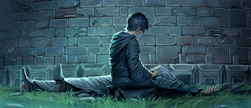
Dumbledore's corpse at the base of the Astronomy Tower
Throughout the year students were taken out of school by their families for safety and fear reasons, such as Eloise Midgen and Hannah Abbott, while two of Draco's botched attempts to assassinate Dumbledore ended up dangerously harming Katie Bell and Ronald Weasley, which only served in increasing the anxiety in the atmosphere. However, when Draco succeeded in allowing the Death Eaters entrance, the full effect came to be when many parents rushed their children home, fearing that even Hogwarts, reputably the safest location in the wizarding world, was no longer safe from Voldemort.[52]
Lost to the Dark forces
- "Severus Snape, long-standing Potions master at Hogwarts School of Witchcraft and wizardry, was today appointed Headmaster in the most important of several staffing changes at the ancient school. Following the resignation of the previous Muggle Studies teacher, Alecto Carrow will take over the post while her brother, Amycus, fills the position of Defence Against the Dark Arts professor."
- — Lord Voldemort takes indirect control of Hogwarts[src]
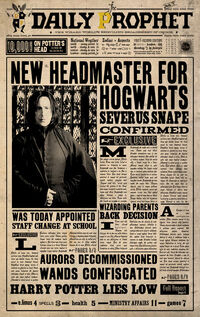
Headmaster Snape
Regardless of the school governors' decision, with the takeover of the Ministry by Voldemort, attendance at Hogwarts was mandatory for all eligible children. New, militaristic requirements were established, such as requiring students to provide proof of blood status. This enabled Voldemort to keep an eye on the entire wizarding world from a young age and identify Muggle-borns, including eleven-year old children who have no knowledge of their magical nature before their forced identification. Such youngsters faced the possibility of never entering Hogwarts nor returning to their homes ever again.[70]
Academic instruction at Hogwarts became corrupted. Muggle Studies became a required subject, and instruction in it took a new tack with an anti-Muggle bias, while Defence Against the Dark Arts had simply become Dark Arts. Students were taught illegal curses outright, with older students being instructed to practise curses on underclassmen. Snape was appointed Headmaster, and Alecto and Amycus Carrow, teachers of Muggle Studies and Dark Arts, respectively, had been assigned as his deputies. It was a time of great terror in which no one could be certain who was friend or foe.[70] Unknown to many, Snape was secretly aiding the Order and the resistance, and stopped the Carrows from inflicting inhumane punishments on erring students.
The climactic battle
- "They stood up at once, and together he, Ron, and Hermione left the Great Hall. Great chunks were missing from the marble staircase, part of the balustrade gone, and rubble and bloodstains occurred every few steps as they climbed."
- — The damage inflicted on the castle from the Battle of Hogwarts[src]
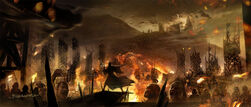
The Battle of Hogwarts
In May 1998, the Battle of Hogwarts took place as one of its most infamous alumni, Tom Riddle, better known by then as Lord Voldemort, returned to attack the school and subdue or destroy its defenders. Voldemort claimed he had no desire to harm the school or its students, but he and his Death Eaters spared no one who opposed them and recklessly damaged the school during their assault.[70]

Harry Potter's final defeat of Voldemort and the end of the Second Wizarding War
Numerous students, staff, parents, graduates, and friends of Hogwarts rose to the school's defence in its hour of need, including the notorious poltergeist Peeves. Thanks to Harry Potter, Lord Voldemort was permanently destroyed and his Death Eaters disbanded forever. Minerva McGonagall became the Headmistress of the school. Harry was celebrated as a true hero.[70]
Hogwarts sustained extensive damage during the battle. Multiple areas of the main building and adjacent areas were set on fire or blown up, and the Quidditch pitch was largely destroyed by fire.[70]
After the battle, Hogwarts was repaired. Some students, such as Hermione Granger, returned to the school in 1998 to complete their education.
A new century
Ten years after the Battle of Hogwarts,[71] normal school life had resumed with Minerva McGonagall still as Headmistress and Rubeus Hagrid still as the Care of Magical Creatures professor and Keeper of Keys and Grounds, and Neville Longbottom had become the Herbology professor and the Head of Gryffindor House.[72]
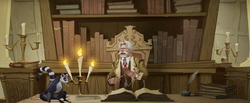
Professor Gorski teaching
In 2009, Jakub Gorski came to the school as the visiting History of Magic professor with his lemur "assistant" Bly, who later turned out to be an Animagus who had bewitched Gorski with the Imperius Curse as a part of his search of the Turner family heirloom. A group of students, including Lottie Turner herself, found out the truth during the school year and foiled Bly's attempt to use Lottie to obtain the heirloom.[72]
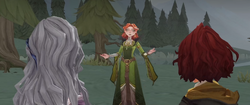
MacGillony greeting students
During the 2010–2011 school year, Elspeth MacGillony was appointed the subtitute Study of Ancient Runes professor while Clodagh Dromgoole was on leave. Her real motive in returning to the school, however, was to find the crown of courage in the Great Lake, and she used the Imperius Curse on several students to make them find it for her. This was discovered by Headmistress McGonagall in time, and MacGillony was sacked and arrested.[72]
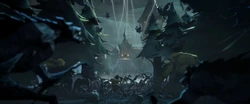
Creatures attacking Hogwarts
In the time that followed, Dementors attacked Hogwarts. At first there were minor-scale attacks, which the staff handled in time, but things took a turn for the worse when the Dementors summoned other dark creatures to fight for them. Headmistress McGonagall assembled the staff and put a magical shield around the castle to block the creatures. They managed to breach the shield regardless, which then led to a big battle.[72]
Time-travel accidents
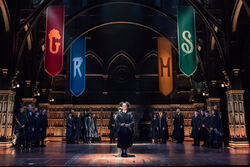
Rose Weasley in the Great Hall
By 2017, many descendants of previous students were now coming to Hogwarts as new pupils, such as Albus Potter, Scorpius Malfoy and Rose Granger-Weasley. In their fourth year in 2020, Albus and Scorpius illegally used a Time-Turner to travel back in time and caused the timeline to deviate, therefore witnessing several alternate versions of Hogwarts in the early 2020s, including a version with only minor differences from the original one, and versions in which Dolores Umbridge was the Head in a world where Voldemort had won the Battle of Hogwarts. Nevertheless, they were eventually successful in correcting the timeline and restoring peace to Hogwarts.[5]
Typical school year
- "Now… to our new students, welcome, to our old students, welcome back! Another year full of magical education awaits you…"
- — Start-of-Term Feast speech[src]

The scarlet Hogwarts Express steam engine on Platform 9¾
Term began on 1 September. Students usually reached Hogwarts via the Hogwarts Express, which left Platform 9¾ of London's King's Cross Station at 11 a.m. sharp.[1] There seemed to be other ways of entering the school, such as via broomsticks or Floo Powder, or simply Apparating to a nearby location such as Hogsmeade. Missing the Hogwarts Express for any reason was a very serious problem, but would not cost the student points as long as they got there before the term had officially started.[51] The Hogwarts Express brought the students to Hogsmeade Station. First years traditionally crossed the Black Lake in boats with the gamekeeper, travelling under an opening in the rocks upon which Hogwarts was built, through a curtain of ivy, and finally into an underground harbour.[1]
Older students travelled on the road in carriages pulled by Thestrals (invisible to any that hadn't witnessed death) to the castle.[69] The Start-of-Term Feast took place in the Great Hall. This feast included the Sorting Ceremony, followed by a few words from the current Headmaster or Headmistress. The banquet started after this, including large quantities of food and drink. The feast was closed with a few more words from the Headmaster or headmistress, including the usual "start-of-term notices".[1]

After dinner, students were led to their house common room by a prefect. This was a special time for new students to get comfortable with their surroundings, because the next day classes would begin. The class schedules were handed out during breakfast by the Heads of House. After two weeks of classes, the Quidditch team trials and flying lessons for the first years usually occured.[1]
Homework was usually assigned to students at the end of classes or at the end of the school term. It was usually completed by students in the Study Hall, Study Area, library, Gryffindor Tower reading room or another common room. A homework planner could be used to help students to keep track of all their homework assignments. Some magical planners also told the students to complete the homework when it was opened. If a student failed to complete the homework or was late in handing it in, they could be given a detention as a punishment.[1]
Hogwarts's school year was structured in a similar way to other non-magical schools and colleges in the UK, with a three-term year punctuated by holidays at Christmas and Easter and bounded by the long summer holiday of nine weeks. Students had the option of staying at Hogwarts for the winter and spring holidays. Those who chose to stay at the castle during the Christmas holidays did not have lessons and attended a feast on Christmas Day. Students also did not have classes the week of Easter, but this was much less enjoyable due to the large amount of work the teachers usually assigned students at this time in preparation for final exams.[1]

Hogsmeade village during Christmas
Other than the breaks and weekends, students did not receive holidays. However, students in the third year and above were allowed to visit Hogsmeade, the local village, occasionally.[68] There were normally four feasts per year: the Start-of-Term Feast at the beginning of the school year, End-of-Term Feast at the end of the school year, and feasts at Hallowe'en and Christmas.[1] Feasts were also called to mark special occasions, such as the beginning of the Triwizard Tournament.[21]
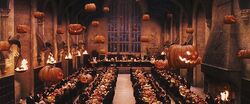
Hallowe'en feast
Classes would proceed normally and the next notable event occurred on the evening of 31 October: the Hallowe'en feast. Decorations included giant pumpkins and flocks of hundreds of bats flying across the halls. The served foods included pumpkin treats, tarts, cakes and all sorts of magical sweets. The Quidditch season started usually with the first Quidditch match in the first weeks of November. In the second week of December, the Deputy Head would take names of those who would stay at Hogwarts over the Christmas holidays. The first term usually ended about a week before Christmas, and most of the students and some of the teachers went home by the school train.[1]

Christmas feast at Hogwarts
In the Triwizard Tournament years, the Yule Ball occurred on the evening of Christmas Day, ending at midnight.[21] On 25 December, a Christmas feast was held in the Great Hall. Shortly after 6 January (Epiphany aka Twelfth Night), the Hogwarts Express returned to Hogsmeade; the second term would begin. The exact dates of the beginning of the Easter holidays varied every year. During these holidays, the students could go home. The final exams were held the first week of June and the results came out on the second week. In the evening before the Hogwarts Express went back to London, the End-of-Term Feast was held, and outgoing students would partake in a graduation ceremony. The Hogwarts Express returned to London during the third week of June. Some staff and all of the students left Hogwarts for summer holidays.[1]
School spirit
- "And be warned: thievery is not tolerated at Hogwarts."
- — Albus Dumbledore explaining the rules of Hogwarts to a young Tom Riddle[src]
The motto of Hogwarts was: "Draco dormiens nunquam titillandus", translated as: Never tickle a sleeping dragon. Quidditch was possibly the most popular sport at the school, with most of the student body turning out to watch each match.[1] Hogwarts also had a Frog Choir which sang at special occasions.[73][74][75]
Coat of Arms
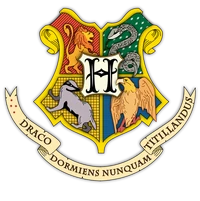
The coat of arms of Hogwarts shows each house's mascot and house colours
- See also: Heraldry
The blazon of the Hogwarts Coat of Arms clockwise from top left: the Gryffindor lion, the Slytherin serpent, the Ravenclaw eagle, and the Hufflepuff badger, all circling the letter 'H'. The motto, "draco dormiens nunquam titillandus", carried in an escroll beneath the shield. The way that the house mascots are arranged makes the centre line divide the houses with warm colours and mammalian mascots from the houses with cold colours and saurian mascots.[1]
School song
There was an official school song, though it was only sung when the Headmaster was in a particularly good mood and deemed it appropriate (which is therefore why it was only known to have been commissioned once from 1991 to 1998).[3] It didn't seem to conform to the strict opinions of older Headmasters and Headmistresses, such as Armando Dippet. As such it may have been an invention of the relaxed Albus Dumbledore, and certainly sounded like it was of his invention.[76] There was no standard rhythm to the song. Everyone could sing it how they like, as such the Weasley twins preferred a slow and deep style. The lyrics are shown below:
- "Hogwarts, Hogwarts, Hoggy Warty Hogwarts,
- Teach us something please,
- Whether we be old and bald,
- Or young with scabby knees,
- Our heads could do with filling,
- With some interesting stuff,
- For now they're bare and full of air,
- Dead flies and bits of fluff,
- So teach us things worth knowing,
- Bring back what we've forgot,
- Just do your best, we'll do the rest,
- And learn until our brains all rot."[3]
Houses
- "We must unite inside her, or we'll crumble from within."
- — The Sorting Hat[src]
Hogwarts students were divided into four houses:
House ghosts

House ghosts (left to right): Bloody Baron, Fat Friar, Sir Nicholas de Mimsy-Porpington, and Helena Ravenclaw
Hogwarts was the most heavily haunted dwelling place in Britain (and this was against stiff competition, as there were more reported ghost sightings/sensings on these damp islands than anywhere else in the world). The castle was a congenial place for ghosts, because the living inhabitants treated their dead friends with tolerance and even affection, no matter how many times they had heard the same old reminiscences. Each of the four Hogwarts houses had its own ghost.[77]
Slytherin boasted the Bloody Baron, who was covered in silver bloodstains. He was well known for being extremely unsocial and many students, including those of his own House, were known to be slightly afraid of him. While alive, he was a hot-tempered man. The least talkative of the house ghosts was the Grey Lady, who was long-haired and beautiful.[77] She was the daughter of Rowena Ravenclaw, making her the only house ghost who was directly related to one of the four Hogwarts founders.[83]
Hufflepuff house was haunted by the Fat Friar, who was executed because senior churchmen grew suspicious of his ability to cure the pox merely by poking peasants with a stick, and his ill-advised habit of pulling rabbits out of the communion cup. Though a genial character in general, the Fat Friar still resented the fact that he was never made a cardinal.[77] He also frequently suggested that Peeves be given a second chance, whether or not he deserved it.[3]
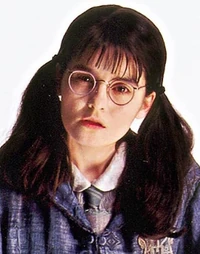
Gryffindor house was home to Nearly Headless Nick, who in life was Sir Nicholas de Mimsy-Porpington. Something of a snob, and a less accomplished wizard than he believed, Sir Nicholas lounged around the court of Henry VII in life, until his foolish attempt to beautify a lady-in-waiting by magic caused the unfortunate woman to sprout tusks. Sir Nicholas was stripped of his wand and inexpertly executed, leaving his head hanging off by a single flap of skin and sinew. His ghost retained a feeling of inadequacy with regard to truly headless ghosts.[77]
Another notable Hogwarts ghost was Moaning Myrtle, who haunted an unpopular girls' toilet. Myrtle was a student in Ravenclaw house at Hogwarts when she died, and she chose to return to school in perpetuity, with the short-term aim of haunting her arch-rival and bully, Olive Hornby. As the decades rolled by, Myrtle had made a name for herself as the most miserable ghost in school, and was usually found to be lurking inside one of the toilets and filling the tiled space with her moans and howls.[77]
Administration
The highest position of staff at Hogwarts was the Headmaster or Headmistress. There was also a Deputy Headmaster or Headmistress, who would take over responsibilities of the Headmaster should the circumstances demand it.[51][52]
Heads of Hogwarts
The Headmaster or Headmistress was appointed by the Hogwarts Board of Governors[84] to oversee the safety and the day-to-day functioning of the school, and had the power to override any decision made by any other authoritative facilitator at the school.
Deputy Heads
The Deputy Headmaster or Deputy Headmistress (depending on gender) assisted the headmaster or headmistress in his or her duties. In the event of a headmaster or headmistress' incapacitation, the deputy also served as temporary head until the Board of Governors could select a new, permanent one.[52]
| Wizard(s) | Time |
|---|---|
| Matilda Weasley's predecessor (possibly) | pre-1890s (possibly) |
| Professor Matilda Weasley | Professor Phineas Nigellus Black's tenure as Headmaster |
| Professor Minerva McGonagall | Professor Albus Dumbledore's tenure as Headmaster |
| Professor Alecto Carrow | Professor Severus Snape's tenure as Headmaster |
| Professor Amycus Carrow |
Heads of House
Head of House was the title held by a Professor at Hogwarts School of Witchcraft and Wizardry who was responsible for looking after the students in one of the four Houses: Gryffindor, Hufflepuff, Ravenclaw or Slytherin. It was possible for a Head of House to serve concurrently as Deputy Head, but not as Headmaster/Headmistress.[1]
| House | Head | Term of office |
|---|---|---|
| Gryffindor | Godric Gryffindor | Medieval times[13] |
| Unidentified Gryffindor lady | ?–pre 1970s | |
| Unidentified Gryffindor seeker | ||
| Unidentified Gryffindor man (II) | ||
| Unidentified Gryffindor man (III) | ||
| Unidentified Gryffindor man (IV) | ||
| Muldoon Cragg | ||
| Uric Oapley | ||
| Podric Piles | ||
| Tobias Stump | ||
| Valeria Myriadd | ||
| Minerva McGonagall | 1970s–1998[88] | |
| Neville Longbottom | By 2008[89] | |
| Hufflepuff | Helga Hufflepuff | Medieval times[13] |
| Pomona Sprout | ?–pre 2017[90] | |
| Ravenclaw | Rowena Ravenclaw | Medieval times[13] |
| Filius Flitwick[91] | ? | |
| Slytherin | Salazar Slytherin | Medieval times[13] |
| Horace Slughorn | ?–1981[92] | |
| Severus Snape | 1981–1997[88] | |
| Horace Slughorn | 1997–?[91] | |
| Unknown house | Prendergast[93] | 1900s-? |
Support staff
|
Position |
Wizard(s) |
Circa |
|---|---|---|
| Caretaker | Rancorous Carpe | fl. 1876 |
| Gladwin Moon | fl. 1890 | |
| Apollyon Pringle | fl. 1960s | |
| Argus Filch | fl. 1970s to 1990s | |
| Matron/Healer | Noreen Blainey | fl. 1890 |
| Poppy Pomfrey | fl. 1970s to 1990s | |
| Nurse Wainscott | fl. 1990s | |
| Gamekeeper | Unidentified 19th-century Hogwarts gamekeeper | fl. 1890 |
| Ogg | fl. 1940s to 1960s | |
| Rubeus Hagrid | 1943 to present | |
| Chief Attendant of Witchcraft Provisions | Lucinda Thomsonicle-Pocus | fl. 1990s |
| Referee and Flight Instructor | Chiyo Kogawa | fl. 1890 |
| Rolanda Hooch | fl. 1990s | |
| Librarian | Agnes Scribner | fl. 1890 |
| Irma Pince | ||
| Unidentified Hogwarts employees | ||
| Keeper of the Keys | Rubeus Hagrid |
Kitchen staff

Hogwarts' kitchen
A veritable legion of house-elves were enlisted by Hogwarts School of Witchcraft and Wizardry. They worked the kitchens, preparing feasts for the entire school. They also moved trunks and baggage to and from rooms, cleaned dormitories, and presumably other areas of the castle as well.
In 1994, they became angry with Hermione as she made attempts to free them. Dobby and Winky, who were under Hogwarts' employ at the time, were considered disgraces to the rest of their colleagues due to Dobby being paid and receiving a vacation, while Winky constantly became drunk out of self-pity.[21]
During the Battle of Hogwarts, the house-elves fought against the Death Eaters with Kreacher leading them. They defended their masters by using kitchen knives to stab at the attackers' ankles.[70]
Subjects and teachers
| 'Engorgio!'
It is requested that this article, or a section of this article, should be expanded. Please help the Harry Potter Wiki by expanding this article to give more complete coverage of its subject. |
- "We teachers are rather good at magic, you know."
- — Description of Hogwarts' Professors[src]
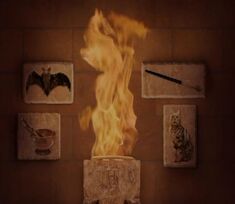
Core subjects: the bat represents Defence Against the Dark Arts, the wand represents Charms, the mortar and pestle represents Potions and the cat represents Transfiguration
Hogwarts had in its faculty an abundance of wise and talented professors. Each specialised in a specific subject.[88][94] Other staff positions included that of a school nurse, caretaker, librarian, and Keeper of the Keys and Grounds of Hogwarts. There were a variety of classes taught at Hogwarts School of Witchcraft and Wizardry.[88][94] These included both the core curriculum and the electives, available from third year forward. Some classes could be dropped in the sixth year.[94]
Numerous lessons were described, instructing the students in various branches of magic. Transfiguration, Defence Against the Dark Arts, Charms, Potions, Astronomy, History of Magic, and Herbology were compulsory subjects for the first five years.[94][95][88] At the end of their second year, students were required to add at least two optional subjects to their syllabus for the start of the third year. Five of the choices were Arithmancy, Study of Ancient Runes, Divination, Care of Magical Creatures, and Muggle Studies.[96][97]
In addition, Horcruxes were a banned subject at Hogwarts, due to their extremely dark and inhumane nature.[98]
Core classes
Electives
| When | Class | Professor | Year |
|---|---|---|---|
| Third year on | Arithmancy | Septima Vector | c. 1991–? |
Care of Magical Creatures |
Silvanus Kettleburn | Early 20th century–1992 | |
| Rubeus Hagrid | 1993–? | ||
| Wilhelmina Grubbly-Plank | 1995 | ||
Divination |
Sybill Trelawney[97] | 1980–1995 | |
| 1996–? | |||
| Firenze[104] | 1996–1998 | ||
Muggle Studies (Core class in the 1997–1998 school year) |
Quirinus Quirrell | ?–1990 | |
| Arif Sikander | 1990–1991[105] | ||
| Male professor | ? | ||
| Charity Burbage[106] | ?-1997 | ||
| Concordia Rowle | Early 21st century[72] | ||
Study of Ancient Runes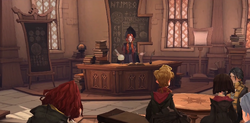 |
Bathsheda Babbling | c. 1991–? | |
| Clodagh Dromgoole | Early 21st century[72] | ||
| Elspeth MacGillony | Substitute teacher in 2010–2011[72] | ||
| Sixth and seventh year (with sufficient demand) |
Advanced Arithmancy Studies | ||
| Alchemy | |||
| Ancient Studies | |||
Apparition |
Wilkie Twycross |
Extra-curricular subjects
Extra-curricular activity
Counselling
- "Well, Potter, this meeting is to talk over any career ideas you might have, and to help you decide which subjects you should continue into the sixth and seventh years. Have you had any thoughts about what you would like to do after you leave Hogwarts?"
- — Harry's appointment with McGonagall[src]

The posting for careers advice
Hogwarts students received career advice from their Heads of House in their O.W.L. year, some weeks prior to the examinations, to help establish what subjects the students needed to concentrate on to achieve the required O.W.L. and N.E.W.T. scores for their chosen occupations.[69]
In fifth year, the students would get career advice, which would help students choose their N.E.W.T. subjects. Bill Weasley told his younger brother Ron about it. Before their examination (during the Easter break) the students would receive a batch of leaflets, advertising different jobs available to Hogwarts students and the N.E.W.T.s required for them. Examples were: Healing, Muggle relations, Wizard banking, Training Security trolls, and working at the Department of Magical Accidents and Catastrophes.[69]
During the first week of summer term, the students discussed their future careers with the Head of Houses during a careers appointment. Harry Potter discussed his wish to become an Auror with McGonagall, who described it as a difficult career path to take. The requirements were high: five N.E.W.T.s. and passing of character and aptitude tests. Auror training then took another three years of study.[69]
Percy Weasley was still reading about his future career possibilities after his careers advice. In Diagon Alley, he read about the later careers of Hogwarts prefects, just before he started his sixth year.[51]
Harry first thought of his career after Hogwarts when he discussed it with Bartemius Crouch Junior (disguised as Alastor Moody) in his fourth year. Crouch suggested that he (and Hermione Granger) would be suitable to become Aurors.[21]
Oddly enough, the students of Hogwarts did not appear to receive similar counselling at the end of their second year, when they chose the elective subjects that could determine their future careers.
Grading system
- Hermione Granger: "So top grade's O for 'Outstanding,' and then there's A —"
- George Weasley: "No, E. E for 'Exceeds Expectations'."
- — Discussion over O.W.L. marks[src]
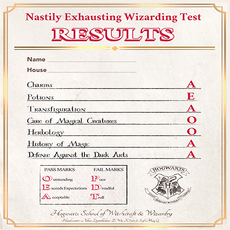
Outstanding W.O.M.B.A.T
Grading on routine homework seemed to be along the same lines as that for Muggle students. Hogwarts students also had more difficult exams as they progressed higher in the system. O.W.L.s (Ordinary Wizarding Levels) were a set of standardised tests for fifth year students, which determined what courses a student could continue to study in their final years at Hogwarts. They were the wizarding equivalent of Muggle O-levels.[69]
N.E.W.T.s (Nastily Exhausting Wizarding Tests) were optional levels of education for exceptional students, much like A-levels for Muggle students. To progress to N.E.W.T.-level, students had to receive certain high marks on O.W.L. exams, otherwise the student would not be able to cope with the increasingly difficult subject matter. N.E.W.T. tests occurred at the end of the seventh year and could not be retaken.[69][52]
Ordinary Wizarding Level Grading System:
|
Pass grades:
|
Fail grades: |
This grading system was also used on W.O.M.B.A.T.s (optional tests taken outside Hogwarts), and was most likely used on N.E.W.T.s also, making this the universal exam grading system in wizarding Britain.[69]
Examinations
End of year exams
All students at Hogwarts were required to complete a set of examinations to get into the next year of schooling. There was one exam for each subject. In fifth year, instead of end of the year exams, students sat their O.W.L.s (Ordinary Wizarding Levels); the score they achieved on these was what allowed them to progress to N.E.W.T.-level. In order to progress to N.E.W.T., a student had to score either an 'Outstanding' or an 'Exceeds Expectations' on their O.W.L.[69]
1992 first year exams
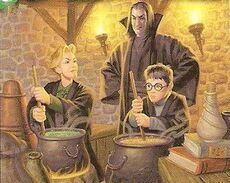
End of the year potions exam
The Charms exam consisted of attributing animation to an otherwise inanimate object. In 1992, the students had to make a pineapple dance across Filius Flitwick's desk.[1]
The Transfiguration exam consisted of transfiguring a being into an object. In 1992, the students had to turn a mouse into a snuff box. Extra points were given for how pretty the snuffbox was, while points were taken off if it still had whiskers.[1]
The Potions exam consisted of brewing a potion from memory. In 1992, and in keeping with Severus Snape's unpleasant sense of humour, the students had to produce a Forgetfulness Potion.[1]
In the 1992 History of Magic exam, the test lasted for one hour and the students were required to answer questions about the invention of the Self-Stirring Cauldron by Gaspard Shingleton.[1]
1993 second year exams
These exams were not set in place due to Dumbledore's decision to cancel them due to the events in the Chamber of Secrets that year.[51]
1994 third year exams
The Charms exam required students to perform the Cheering Charm, Freezing Spell,[121] and others. A separate room stood at the ready, if a student overdid their Cheering Charm.[68]
The Transfiguration exam was said to contain difficult tasks, as when finished students emerged "limp and ashen-faced." The exam included turning a teapot into a tortoise. Some students' tortoises still had tails, could breathe steam, and had willow-patterned shells.[68]
The Potions exam was to brew a Confusing Concoction. Points were taken off if students could not get their batch to thicken, as was required.[68]
The History of Magic exam may have included questions on Witch Hunts, as students were required to complete homework on the subject.[68]

The Defence Against the Dark Arts exam consisted of an obstacle course. It contained dark creatures, which included wading across a deep paddling pool containing a Grindylow, a series of potholes full of Red Caps, squishing your way across a patch of marsh while ignoring the misleading directions of a Hinkypunk, then climbing into an old trunk in order to battle a Boggart.[68]
The Divination exam included looking into a crystal ball and being able to distinguish what could be seen. Both Harry Potter and Ronald Weasley chose to simply make something up. Harry's prediction, of a hippogriff flying away, turned out to be accurate. As nobody was mentioned as having failed the exam despite several students admitting they were just making things up, it is likely that anyone who at least pretended to see something would have been given a pass.[68]
1995 fourth year exams
The History of Magic exam involved testing the students on their knowledge of Goblin rebellions.[21]
Ordinary Wizarding Level
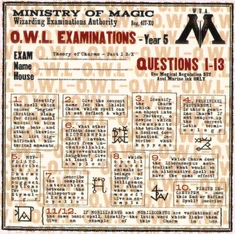
A Theory of Charms O.W.L. exam paper
An Ordinary Wizarding Level (often abbreviated O.W.L.) was a subject-specific test taken during Hogwarts School of Witchcraft and Wizardry students' fifth year. These exams were administrated by the Wizarding Examinations Authority. The score made by a student on a particular O.W.L. determined whether or not he or she would be allowed to continue taking that subject in subsequent school years, and whether they might be successful in obtaining a particular job.[69]
Each exam had a written and practical assessment, so students could demonstrate both their practical and theoretical knowledge. The exams were taken over a two week period.[69]
Nastily Exhausting Wizarding Test
A Nastily Exhausting Wizarding Test (often abbreviated N.E.W.T.) was a subject-specific exam that seventh year witches and wizards at Hogwarts School of Witchcraft and Wizardry took to help them pursue certain careers after their graduation. For instance, the Ministry of Magic only accepted Auror applicants with at least five N.E.W.T.s with top grades of either 'Outstanding' or 'Exceeds Expectations'.[69]
Not much was known about these exams. Some students did not take these exams at all, as some careers in the Wizarding World did not require N.E.W.T.s.
Student years
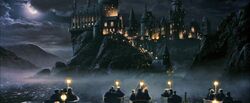
The first-year students on their way to Hogwarts
A first-year was a student at Hogwarts School of Witchcraft and Wizardry who was new to Hogwarts and in their first year of magical education. First-years were typically eleven to twelve years of age. First-years arrived at the castle by crossing the lake with the Keeper of the Keys in boats separate from the older students. They were not allowed to own a broomstick or be on one unless they were attending Flying class. An exception had been made for Harry Potter because he joined the Gryffindor house team due to his exceptional skills with a broomstick.
First-year classes consisted of: Potions, Herbology, Defence Against the Dark Arts, Transfiguration, History of Magic, Astronomy, Charms, and Flying.[1]

School carriages being pulled to Hogwarts castle
A second-year was a student at Hogwarts School of Witchcraft and Wizardry who was in their second year of magical education. Second-years were typically twelve to thirteen years of age unless a student had to repeat the second form. The second year was the first year in which students were allowed to go with the rest of the school in the school carriages pulled by Thestrals up to the castle.
Second-year classes consisted of: Potions, Herbology, Defence Against the Dark Arts, Transfiguration, History of Magic, Astronomy, and Charms. Unlike first-years, second-years were not obligated to attend Flying classes, although they were allowed to bring their own broomsticks. At the end of the year, second-year students chose two or more classes they wished to study as electives the following year.[51]
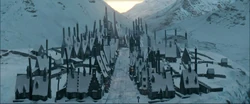
Year in which students visit Hogsmeade
A third-year was a student at Hogwarts School of Witchcraft and Wizardry who was in their third year of magical education. Third-years were typically thirteen to fourteen years of age. Third-years were permitted to go to Hogsmeade during certain weekends if they had a signed permission form from their parent/guardian.[68]
The third year was an important one for students, as it was the first year that they were permitted to sit elective courses. Third-year classes consisted of: Potions, Herbology, Defence Against the Dark Arts, Transfiguration, History of Magic, Astronomy, Charms, and the two or more electives the student chose the previous year.
A fourth-year was a student at Hogwarts School of Witchcraft and Wizardry who was in their fourth year of magical education. Fourth-years were typically fourteen to fifteen years of age. The fourth form was almost identical in its structure to the third; students sat two or more elective courses in addition to the core classes, and were allowed into Hogsmeade during selected weekends.
Fourth-year classes consisted of: Potions, Herbology, Defence Against the Dark Arts, Transfiguration, History of Magic, Astronomy, Charms, and two or more electives. However, fourth-years typically got more work than third-years, so as to prepare for their O.W.L.s.[21]

O.W.L. examination
A fifth-year was a student at Hogwarts School of Witchcraft and Wizardry who was in their fifth year of magical education. Fifth-years were typically fifteen to sixteen years of age. The fifth year was enormously important for students, due to the fact that it was the year in which they must sit their O.W.L. exams, which would determine what N.E.W.T. courses they would be permitted to take later on in their education. O.W.L.s determined what jobs they could apply for in their future careers.[69]
The fifth year was also the year in which students received career counselling from their Heads of House. It was during this meeting that they would be advised as to what N.E.W.T.-level classes they should take in order to qualify for their desired career. Fifth-year classes consisted of: Potions, Herbology, Defence Against the Dark Arts, Transfiguration, History of Magic, Astronomy, Charms, and two or more electives. Before the beginning of the year, one boy and one girl were selected by the Headmaster from each house to become Prefects.[69]

N.E.W.T-level Potions lesson
A sixth-year was a student who was in his or her sixth year of magical education at Hogwarts School of Witchcraft and Wizardry. Sixth-years were typically sixteen to seventeen years of age, although some could be older, if they have had to repeat a year like Marcus Flint did. The sixth year was the first year in which students sat N.E.W.T.-level classes. Sixth-years could also elect to take part in Apparition lessons for a fee of twelve Galleons.[52]
Based on students' O.W.L. scores, and depending on the minimum requirements of the professor teaching the subject at the time, students were allowed to sit any number of classes as long as they met said requirements. If the student didn't meet those requirements, they could not attend the N.E.W.T.-level classes, having to repeat the O.W.L.-level classes and the fifth-year exams. While students did have the opportunity to choose whether they wished to continue in particular subjects, those who began studying N.E.W.T.-level subjects in their sixth year were expected to carry on with the subject into the seventh year and sit the N.E.W.T. exam in that subject. Sixth-year students were initially excited to have more free time, but this extra time was intended to help them study and do homework, as many, if not all, teachers assigned more homework and gave more difficult lessons in their N.E.W.T.-level classes.[52]
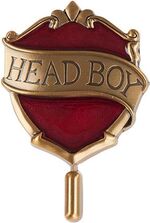
The Head Boy pin
A seventh-year was a student at Hogwarts School of Witchcraft and Wizardry who was in their seventh and final year of formal magical education. Seventh-years were typically seventeen to eighteen years of age, although some may be older if they have had to repeat a year. The seventh year contained the most important exams given at Hogwarts — the N.E.W.T.s.[52]
Students concluded their N.E.W.T.-level studies in the seventh year, at the end of which they sat the N.E.W.T. exam pertaining to each of their subjects. A student in the seventh year would have the same schedule they had in the sixth year, and would sit only those classes in which they received O.W.L.s meeting the minimum requirement of the professor for that subject. However, not all students would take N.E.W.T.s, as some occupations required only O.W.L.s.[52]
Every year, a male and female seventh-year were appointed Head Boy and Head Girl. In most cases, the Headmaster selected the Head students from the seventh-year Prefects. However, students that had never been Prefects, for example Harry's father James Potter, could still be selected.[1] The graduation would have the students ride the boats out from the boat dock under Hogwarts onto the black sea and land at Hogsmeade Station and ride the Hogwarts Express back to King's Cross Station.[122]
Daily routine
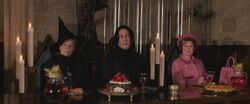
Professors McGonagall, Snape, and Umbridge
The day would begin at 7:30 a.m. with breakfast in the Great Hall. During breakfast, the mail arrived in a flurry of hundreds of owls. A bell chime signalled the start of the first class at 9 a.m. The bell chimed again in one hour to signal the start of the next class.[1]
There were two class periods before lunch, scheduled according to house, though N.E.W.T. students could have breaks during some of these. After lunch, there was another break and two more classes. If there was a heavy snowstorm in between periods, certain lessons that took place outside (such as Care of Magical Creatures) could be cancelled, since it would be difficult for students to traverse from the castle to the outside.[51]
Dinner was served in the Great Hall towards the evening, after which the students were expected to be in their house common rooms for studying and socialising.[1]
There were Astronomy classes at night on Wednesdays every week (usually midnight).[1]
The students had to be in bed or in the common rooms by a certain time, after which was called 'after hours'.[1] The times were different for different years (for example, fifth years were allowed to be in the halls until 9:00 p.m.)[21]
Recruitment
- "...both Beauxbatons and Durmstrang have a larger studentship than Hogwarts."
- — Hogwarts' student ratio[src]
Before school term
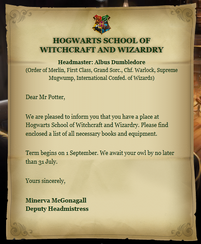
Hogwarts acceptance letter
Each year, the Hogwarts Deputy Headmaster sent letters to eligible witches and wizards who would be eleven years old at the start of the incoming term. These letters invited the children to be students at Hogwarts. If for any reason a letter did not reach its intended recipient, owls would continue delivering letters until the person received one (as was Harry Potter's experience when he turned eleven). The letter contained a list of needed supplies, signed by the Chief Attendant of Witchcraft Provisions, Lucinda Thomsonicle-Pocus, which included uniform clothing, spell books, and cauldrons. Letters were also sent to existing students to inform them of the new supplies needed. Students usually obtained school supplies at Diagon Alley in London.[1]
Letters to Muggle-born witches and wizards, such as Hermione and Harry's mother Lily Evans, as well as Tom Marvolo Riddle (Voldemort) and Harry (half-bloods who lived with Muggles and knew nothing of the wizarding world), who may not have been aware of their powers and were unfamiliar with the concealed wizarding world, were delivered in person by a member of Hogwarts staff, who then explained to the parents/guardians about magical society, and reassured them regarding this news. They also assisted the family in regards to buying supplies and gaining access to Diagon Alley.[51]

Harry Potter's Hogwarts letters being delivered to privet drive
Harry's letter was sent via normal owl delivery, since Professor Dumbledore had presumed that the Dursleys had explained to Harry about Hogwarts and the wizarding world. When no response came from the first, several more letters, each reflecting Harry's new location, were sent. Ultimately, Hagrid was dispatched to hand-deliver Harry's final letter. Once he found Harry, who was with the Dursleys in their vain attempt to keep all wizarding knowledge from Harry, Hagrid explained all about Harry's parents and what had really happened the night they died.[1]
While Remus Lupin's father was a wizard, Dumbledore personally visited the family to invite the boy to Hogwarts given the fact that Remus had been afflicted by lycanthropy. Remus noted that it was only after Dumbledore became headmaster that he could have been accepted at Hogwarts.[87]
Students were allowed to bring a cat, an owl or a toad,[1] but exceptions such as rats and Pygmy Puffs were made. Moreover, students did not have to pay tuition fee, because the British Ministry of Magic covered the cost of all students' magical education.[52][123]
While most wizards and witches in Great Britain and Ireland were educated in Hogwarts, they were not obligated to attend if they did not wish to, as some parents were noted to have home-educated their children (as Lyall Lupin originally intended to do for his son due to his condition) or send them abroad (as Lucius originally intended for his son Draco to Durmstrang Institute). This was temporarily changed in the 1997–1998 school year, in which the new Voldemort-installed regime mandated all eligible children to attend in order to weed out Muggle-borns from the school.[70]
Quidditch
- "Quidditch trials will be held in the second week of the term. Anyone interested in playing for their House teams should contact Madam Hooch."
- — Albus Dumbledore announcing upcoming Hogwarts Quidditch tryouts at the 1991 Start-of-Term Feast[src]

A 1991 Quidditch match
Tryouts for House Quidditch teams happened at the very beginning of the school year. The Heads of house had a list of applicants, which they would pass on to the team captain, so the captain could schedule tryouts at their leisure. First years were usually prohibited from joining a Quidditch team, because they were usually inexperienced with brooms and were forbidden to own them in the first place.[1]
However, exceptions had been made on both counts. Harry Potter was a noticeable exception, he was allowed to join the team in his first year and was the youngest Seeker in a century. Teams had different reputations; before Harry joined in 1991, the Gryffindor team was noted by McGonagall to be on a losing streak and that she could not bear any more of Severus Snape's boasting.[1]
The Slytherin team was considered to have no qualms with cheating and unsportsmanlike conduct. It was noted that the Slytherin team recruited players of brute strength, rather than skill.[1][51][68][69][52]
|
Houses |
Gryffindor Quidditch team | Hufflepuff Quidditch team | Ravenclaw Quidditch team | Slytherin Quidditch team |
|---|---|---|---|---|
| Mascot | Lion | Badger | Eagle | Serpent |
| Robe colour(s) | Scarlet and gold | Yellow and black | Blue and bronze | Green and silver |
| Known captains of the 1990s | Cedric Diggory | Roger Davies | Marcus Flint | |
| Oliver Wood | Graham Montague | |||
| Angelina Johnson | Urquhart | |||
| Harry Potter |
Holidays
Students could go home for certain holidays such as Christmas and Easter. The students who chose to remain were treated to a feast along with some of the faculty.[1]

Hogwarts Christmas feast
When Christmas holidays ended, classes would begin again. In Harry Potter's second year, Gilderoy Lockhart organised a Valentine's Day celebration which was not continued after he left the school.[51]
The Easter holidays were not as enjoyable as the Christmas ones, as students were overloaded with homework in preparation for their exams, which were taken at the end of the year. Students were not allowed to use magic over the summer holidays until they turned seventeen; magic was also banned in corridors.[1]
Uniform
- "Uniform
1. Three sets of plain work robes (black)
2. One plain pointed hat (black) for day wear
3. One pair of protective gloves (dragon hide or similar)
4. One winter cloak (black, silver fastenings)
Please note that all student's clothes should carry name tags at all times." - — First-year Shopping List for Hogwarts School of Witchcraft and Wizardry
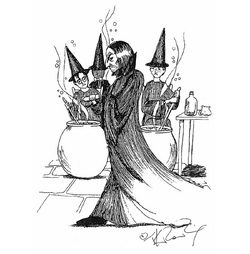
The students at Hogwarts School of Witchcraft and Wizardry were required to wear a uniform. The uniform consisted of a black robe and a black pointed hat (for daywear). Students wore their own socks and shoes. Students had to wear their uniforms during all lessons, and while eating meals or studying in the Great Hall. Students were allowed to wear their own clothes after lessons in their House dormitory and during the holidays.
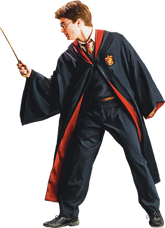
Most students were seen still wearing their uniforms in their house dormitory, most probably because they would need to change into their pyjamas to sleep before they go to bed, so they may feel that it is troublesome to change into their own clothes, then change again into their pyjamas.[1]
Etymology
J. K. Rowling speculated that she might have subconsciously produced the name Hogwarts from the Hogwort plant she saw when walking round Kew Gardens.[124] In the film Labyrinth, Sarah, acted by Jennifer Connelly, meets a goblin outside the gates of the Labyrinth who introduces himself as Hoggle. As they depart, she calls him "Hogwart" instead of his proper name, Hoggle. Also in the film Labyrinth, Jareth the Goblin King, acted by David Bowie, often calls his goblins by the wrong names and at one point he incorrectly calls Hoggle "Hogwart." It is, of course, possible that the name may have derived from the word "Warthog", but simply reversed.
Behind the scenes
- The school's full name suggests that there must be a difference between witchcraft and wizardry, which are otherwise known simply as magic. It can be assumed that witchcraft is magic when performed by females and wizardry by males.
- According to Remus Lupin, attendance at Hogwarts by British students is not mandatory; they may be home schooled by their parents, or sent to another magical school;[125] (this rule was changed during the 1997–1998 school year, but was presumably restored after the demise of Voldemort.) It is likely this extended to Lucius Malfoy's also expressed interest in his son attending the Durmstrang Institute.[21]
- There are two Headmasters known to have held the title more than once; they were Minerva McGonagall and Albus Dumbledore.
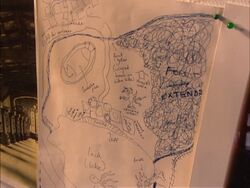
Original hand-drawn layout of Hogwarts
- J. K. Rowling revealed that Hogwarts is a state school, and the Ministry of Magic shoulders all of the school's financial needs.[10]
- There may be an exchange programme for Hogwarts and Ilvermorny. The Damen Blue Line Subway Station in Chicago, Illinois, is, according to J. K. Rowling, where students make the exchange.[126]
- J. K. Rowling said she wanted a humorous motto for Hogwarts since so many schools have less pragmatic ones such as "Reach for the stars".
- Subjects in Hogwarts had different names in Rowling's earliest notes: Herbology was called "Herbalism" and Transfiguration was called "Transfiguration/Metamorphosis." Core subjects were also different, with Divination, Alchemy, and a subject called simply "Beasts" all being compulsory from the first year.
- Hogwarts Legacy likely paid homage to the scrapped 'Beasts' class by having Beasts (class) be the 19th century precursor to Care of Magical Creatures.
- The school song is only sung in the first book, and partially by Hermione and Hagrid in the fourth film. However, the song is sung completely in the deleted scenes as a welcoming to the students of Beauxbatons and Durmstrang, which can be credited to one of the many eccentricities of Albus Dumbledore.
- A board game called Destination Hogwarts is based on the school and castle.
- In the Harry Potter and the Philosopher's Stone video game, a Muggle Studies Classroom is featured on the fifth floor, and an Ancient Runes Classroom is on the sixth floor.
- In Harry Potter and the Half-Blood Prince, Dumbledore believes that Hogwarts is the place Tom Riddle felt was his real home. Ironically, this is also how Harry Potter felt about Hogwarts which is why it was stated that Harry's stomach lurched when Dumbledore told him this.
- J. K. Rowling said in an interview that there are about one thousand students attending Hogwarts at any given time. Assuming that the number of students is divided equally according to House, gender and year, there would be 250 students per House, 125 boys and 125 girls. In a given House and in each year at the school, there would be around 36 students (250 divided by 7 equals 35.7), or 18 boys and 18 girls.
- However, the books mention no more than five students of the same gender, House and year. For example, no other Gryffindor boys in Harry's year besides Ron, Neville, Seamus and Dean are known. Assuming an equal division, that means there are 10 students per year in one House, 70 per House and 280 in the whole school. The films also show, approximately, this number of students.
- Rowling's statement is supported by the fact that, when Harry sees his father doing his O.W.L. (in the Pensieve in Snape's office), there are over 150 students. Secondly, during a Quidditch match, everybody was supporting Gryffindor except around 200 Slytherins supporting their own. It is also possible that there are more dormitories that don't appear in the books and films. The only ones mentioned in the books are the ones that house the students who are actually in the book, e.g. Harry, Ron, Neville, Hermione.
- Another theory is that Harry's year was an unusually small intake, due to the fact that the time at which those students would've been conceived was during the height of the First Wizarding War and many wizarding families may have been reluctant to bring children into the world at such a dangerous time.
- In Harry Potter: Hogwarts Mystery, Year 5, "THE CURSE-BREAKER'S GAMBIT" Achievement, which takes place during the 1989–1990 school year, Murphy McNully, Jacob's sibling, and Minerva McGonagall represented 0.018% of Hogwarts's population that year, which would mean that year there was a total population of 16,667 people at Hogwarts. This seems to contradict Rowling's statement, however that year could have had an unusually large intake or possibly there were around 15,000 non-student inhabitants at Hogwarts (such as ghosts).[127]
- It is rumoured that on the W.O.M.B.A.T. test, Rowena Ravenclaw had a dream that a warty hog was leading her to a lake and that's how Hogwarts got its name.
- J. K. Rowling has said in an interview that Hogwarts is a multi-faith school,[128] and later confirmed that every "religion/belief/non-belief system" is represented at Hogwarts other than Wicca,[129] as she felt this was a "different concept of magic" as compared to that taught at Hogwarts.[130]
- In Harry Potter and the Deathly Hallows: Part 2, the Anti-Disapparition Jinx was lifted in 1998 as Draco Malfoy could apparate to Blaise Zabini and Gregory Goyle. OBS: This is only shown in the films, and the films are known to take liberties with the rules established in the books, often in the interest of dramatic effect or convenience.
- On the subject of house-elves, J. K. Rowling believed Helga Hufflepuff did what was the most moral thing to do at that time.[131]
- The Hogwarts uniform worn in the books consists of a black robe and a black pointed hat. The robes bear no marks to distinguish between the houses. Students wear their own socks and shoes.
- The uniform portrayed in the films consists of a white collared, long sleeved shirt, a tie of their house colours (getting more sophisticated each year), a grey jumper vest, black slacks for males and a black, knee length skirt for females paired with black or grey socks. Both genders wear black comfortable shoes. Each student wears a cloak that bears their house crest on the front, right side and has a lining of their house color: green for Slytherin, red for Gryffindor, blue for Ravenclaw, and yellow for Hufflepuff. During the winter months, a grey jumper replaces the jumper vest for comfort and a scarf bearing their two house colours is worn for warmth. A black pointed hat is provided but is only worn for special occasions such as the opening ceremony, special dinners, house cup ceremony etc.
Appearances
- Harry Potter and the Philosopher's Stone (First appearance)
- Harry Potter and the Philosopher's Stone (film)
- Harry Potter and the Philosopher's Stone (video game)
- Harry Potter and the Chamber of Secrets
- Harry Potter and the Chamber of Secrets (film)
- Harry Potter and the Chamber of Secrets (video game)
- Harry Potter and the Prisoner of Azkaban
- Harry Potter and the Prisoner of Azkaban (film)
- Harry Potter and the Prisoner of Azkaban (video game)
- Harry Potter and the Goblet of Fire
- Harry Potter and the Goblet of Fire (film)
- Harry Potter and the Goblet of Fire (video game)
- Harry Potter and the Order of the Phoenix
- Harry Potter and the Order of the Phoenix (film)
- Harry Potter and the Order of the Phoenix (video game)
- Harry Potter and the Half-Blood Prince
- Harry Potter and the Half-Blood Prince (film)
- Harry Potter and the Half-Blood Prince (video game)
- Harry Potter and the Deathly Hallows
- Harry Potter and the Deathly Hallows: Part 1 (Mentioned only)
- Harry Potter and the Deathly Hallows: Part 2
- Harry Potter and the Deathly Hallows: Part 2 (video game)
- Harry Potter and the Cursed Child
- Harry Potter and the Cursed Child (play)
- Fantastic Beasts and Where to Find Them (Mentioned only)
- Quidditch Through the Ages (Mentioned only)
- The Tales of Beedle the Bard (Mentioned only)
- Fantastic Beasts and Where to Find Them: The Original Screenplay (Mentioned only)
- Fantastic Beasts and Where to Find Them (film) (Appears in photographs)
- Fantastic Beasts: The Crimes of Grindelwald - The Original Screenplay
- Fantastic Beasts: The Crimes of Grindelwald
- Fantastic Beasts: The Secrets of Dumbledore - The Complete Screenplay
- Fantastic Beasts: The Secrets of Dumbledore
- Pottermore
- Harry Potter (website)
- J. K. Rowling's official site (Mentioned only)
- J. K. Rowling: A Year in the Life (Mentioned only)
- The Road to Hogwarts Sweepstakes
- The Art of Harry Potter: Mini Book of Graphic Design
- Harry Potter: The Wand Collection (Mentioned only)
- Harry Potter Official Site
- The Wizarding World of Harry Potter
- Harry Potter: The Character Vault
- Harry Potter: The Creature Vault
- Harry Potter Trading Card Game
- Harry Potter: Quidditch World Cup
- Harry Potter for Kinect
- Wonderbook: Book of Spells
- Wonderbook: Book of Potions
- LEGO Harry Potter
- LEGO Harry Potter: Building the Magical World
- LEGO Harry Potter
- LEGO Creator: Harry Potter
- Creator: Harry Potter and the Chamber of Secrets
- LEGO Harry Potter: Years 1-4
- LEGO Harry Potter: Years 5-7
- LEGO Dimensions
- Harry Potter: Hogwarts Mystery
- Harry Potter: Wizards Unite
- Harry Potter: Magic Awakened
- Harry Potter: Puzzles & Spells
- Hogwarts Legacy
- Harry Potter: Quidditch Champions
- Harry Potter: Magic Caster Wand
- The Harry Potter Wizarding Almanac
Notes and references
- ↑ 1.00 1.01 1.02 1.03 1.04 1.05 1.06 1.07 1.08 1.09 1.10 1.11 1.12 1.13 1.14 1.15 1.16 1.17 1.18 1.19 1.20 1.21 1.22 1.23 1.24 1.25 1.26 1.27 1.28 1.29 1.30 1.31 1.32 1.33 1.34 Harry Potter and the Philosopher's Stone
- ↑ Fantastic Beasts and Where to Find Them: The Original Screenplay
- ↑ 3.00 3.01 3.02 3.03 3.04 3.05 3.06 3.07 3.08 3.09 3.10 3.11 3.12 3.13 3.14 3.15 3.16 3.17 3.18 Harry Potter and the Philosopher's Stone, Chapter 7 (The Sorting Hat)
- ↑ 4.0 4.1 4.2 4.3 Writing by J. K. Rowling: "Wizarding Schools" at Harry Potter (website)
- ↑ 5.0 5.1 Harry Potter and the Cursed Child
- ↑ 1997 interview in The Herald (Glasgow)
- ↑ 7.0 7.1 Writing by J. K. Rowling: "The Hogwarts Express" at Harry Potter (website)
- ↑ 3 July 1999 interview in the Telegraph
- ↑ 8 July 2000 South West News Service interview
- ↑ 10.0 10.1 http://hellogiggles.com/jk-rowling-hogwarts-costs/2/
- ↑ "World Exclusive Interview with J K Rowling," South West News Service, 8 July 2000 - "Hogwarts just serves Britain and Ireland."
- ↑ Writing by J. K. Rowling: "The Quill of Acceptance and The Book of Admittance" at Harry Potter (website)
- ↑ 13.0 13.1 13.2 13.3 13.4 13.5 13.6 13.7 13.8 13.9 Harry Potter and the Chamber of Secrets, Chapter 9 (The Writing on the Wall)
- ↑ Harry Potter and the Order of the Phoenix, Chapter 11 (The Sorting Hat's New Song)
- ↑ Writing by J. K. Rowling: "Peeves" at Harry Potter (website)
- ↑ Wizarding World of Harry Potter Grand Opening June 18: Details About Hogwarts Emerge at The Leaky Cauldron
- ↑ Wizarding World of Harry Potter Grand Opening June 18: Details About Hogwarts Emerge at The Leaky Cauldron
- ↑ Harry Potter: Wizards Unite
- ↑ Harry Potter: Hogwarts Mystery, Year 4, Side Quest "Nearly Headless Nick"
- ↑ Harry Potter and the Half-Blood Prince, Chapter 20 (Lord Voldemort's Request)
- ↑ 21.00 21.01 21.02 21.03 21.04 21.05 21.06 21.07 21.08 21.09 21.10 21.11 21.12 Harry Potter and the Goblet of Fire
- ↑ Writing by J. K. Rowling: "Floo Powder" at Harry Potter (website)
- ↑ Hogwarts Legacy
- ↑ 24.0 24.1 Hogwarts Legacy, Main Quest "The Map Chamber"
- ↑ Hogwarts Legacy, Main Quest "Secrets of the Restricted Section"
- ↑ 26.0 26.1 Hogwarts Legacy, Main Quest "Percival Rackham's Trial"
- ↑ 27.0 27.1 27.2 Hogwarts Legacy, Main Quest "Charles Rookwood's Trial"
- ↑ 28.0 28.1 Hogwarts Legacy, Main Quest "Niamh Fitzgerald's Trial"
- ↑ 29.0 29.1 Hogwarts Legacy, Main Quest "San Bakar's Trial"
- ↑ Writing by J. K. Rowling: "Chamber of Secrets" at Harry Potter (website)
- ↑ 31.0 31.1 Writing by J. K. Rowling: "Peeves" at Harry Potter (website)
- ↑ Hogwarts Legacy, Main Quest "The Caretaker's Lunar Lament"
- ↑ The Art and Making of Hogwarts Legacy (see this image)
- ↑ Harry Potter and the Order of the Phoenix, Chapter 6 (The Noble and Most Ancient House of Black)
- ↑ Hogwarts Legacy (see this video)
- ↑ Hogwarts Legacy, Main Quest "Charms Class"
- ↑ Hogwarts Legacy, Main Quest "The Polyjuice Plot"
- ↑ 38.0 38.1 Hogwarts Legacy, Main Quest "Welcome to Hogwarts"
- ↑ Hogwarts Legacy, Main Quest "The Path to Hogwarts"
- ↑ Hogwarts Legacy, Main Quest "Jackdaw's Rest"
- ↑ Hogwarts Legacy, Main Quest "Lodgok's Loyalty"
- ↑ Hogwarts Legacy, Main Quest "Wand Mastery"
- ↑ Hogwarts Legacy, Main Quest "The Final Repository"
- ↑ Hogwarts Legacy, Relationship Quest "Harlow's Last Stand"
- ↑ Hogwarts Legacy, Main Quest "Weasley After Class"
- ↑ Hogwarts Legacy, Relationship Quest "A Bird in the Hand"
- ↑ Hogwarts Legacy, Relationship Quest "In the Shadow of the Relic"
- ↑ 48.0 48.1 48.2 48.3 48.4 Fantastic Beasts: The Crimes of Grindelwald - The Original Screenplay
- ↑ Fantastic Beasts and Where to Find Them (film) (see this image)
- ↑ Fantastic Beasts: The Secrets of Dumbledore
- ↑ 51.00 51.01 51.02 51.03 51.04 51.05 51.06 51.07 51.08 51.09 51.10 51.11 51.12 51.13 Harry Potter and the Chamber of Secrets
- ↑ 52.00 52.01 52.02 52.03 52.04 52.05 52.06 52.07 52.08 52.09 52.10 52.11 52.12 Harry Potter and the Half-Blood Prince
- ↑ Harry Potter and the Order of the Phoenix, Chapter 28 (Snape's Worst Memory)
- ↑ Harry Potter: Hogwarts Mystery, Year 1, Chapter 1 (Your Journey Begins)
- ↑ Harry Potter: Hogwarts Mystery, Year 2, Chapter 10 (The Vault of Ice)
- ↑ Harry Potter: Hogwarts Mystery, Year 3, Chapter 1 (Year Three Begins) - Herbology Lesson "Valerian Sprigs"
- ↑ 57.0 57.1 Harry Potter: Hogwarts Mystery, Year 4, Chapter 1 (Year Four Begins)
- ↑ Harry Potter: Hogwarts Mystery, Year 5, Chapter 2 (Grave Danger)
- ↑ Harry Potter: Hogwarts Mystery, Year 3, Chapter 9 (The Vault of Fear)
- ↑ Harry Potter: Hogwarts Mystery, Year 4, Chapter 16 (The Forest Vault)
- ↑ 61.0 61.1 Harry Potter: Hogwarts Mystery, Year 5, Chapter 30 (Into the Vault)
- ↑ Harry Potter: Hogwarts Mystery, Year 6, Chapter 5 (Wherefore Art Thou, Weasleys?)
- ↑ Harry Potter: Hogwarts Mystery, Year 6, Chapter 2 (Curses and Prophecies)
- ↑ Harry Potter: Hogwarts Mystery, Year 6, Chapter 18 (Into the Forest)
- ↑ Harry Potter: Hogwarts Mystery, Year 6, Chapter 19 (A Farewell to a Friend)
- ↑ Harry Potter: Hogwarts Mystery, Year 6, Chapter 20 (A Circle of Friends)
- ↑ Harry Potter: Hogwarts Mystery, Year 6, Chapter 42 (The Final Vault)
- ↑ 68.00 68.01 68.02 68.03 68.04 68.05 68.06 68.07 68.08 68.09 68.10 68.11 68.12 68.13 Harry Potter and the Prisoner of Azkaban
- ↑ 69.00 69.01 69.02 69.03 69.04 69.05 69.06 69.07 69.08 69.09 69.10 69.11 69.12 69.13 69.14 69.15 Harry Potter and the Order of the Phoenix
- ↑ 70.0 70.1 70.2 70.3 70.4 70.5 70.6 70.7 Harry Potter and the Deathly Hallows
- ↑ Harry Potter: Magic Awakened official website - Notable Alumni - "For fans of Harry Potter, there are many familiar faces from the series that appear in Harry Potter: Magic Awakened. Taking place ten years after the Battle of Hogwarts, many past alumni and professors have become valuable members of the school's faculty…"
- ↑ 72.0 72.1 72.2 72.3 72.4 72.5 72.6 72.7 72.8 72.9 Harry Potter: Magic Awakened
- ↑ 73.0 73.1 73.2 Harry Potter and the Prisoner of Azkaban (film)
- ↑ 74.0 74.1 Harry Potter and the Half-Blood Prince (film)
- ↑ Harry Potter: Hogwarts Mystery, Year 3, "The Frog Choir" Achievement
- ↑ JK's official site (text only), accessed 28/7/2011
- ↑ 77.0 77.1 77.2 77.3 77.4 77.5 77.6 77.7 77.8 Writing by J. K. Rowling: "Hogwarts Ghosts" at Harry Potter (website)
- ↑ 78.0 78.1 78.2 78.3 Harry Potter and the Philosopher's Stone, Chapter 3 (The Letters from No One)
- ↑ 79.0 79.1 79.2 79.3 Writing by J. K. Rowling: "Colours" at Harry Potter (website)
- ↑ Transcription of new Pottermore information
- ↑ Harry Potter and the Deathly Hallows, Chapter 29 (The Lost Diadem)
- ↑ Harry Potter and the Chamber of Secrets, Chapter 12 (The Polyjuice Potion)
- ↑ Harry Potter and the Deathly Hallows, Chapter 31 (The Battle of Hogwarts)
- ↑ Harry Potter and the Chamber of Secrets, Chapter 14 (Cornelius Fudge)
- ↑ The Wizarding World of Harry Potter
- ↑ Harry Potter and the Chamber of Secrets (film) - DVD (Disc 2)
- ↑ 87.0 87.1 87.2 Harry Potter and the Prisoner of Azkaban, Chapter 18 (Moony, Wormtail, Padfoot and Prongs) - Remus Lupin said "I was a very small boy when I received the bite...But then Dumbledore became Headmaster, and he was sympathetic." Writing by J. K. Rowling: "Remus Lupin" at Harry Potter (website) states he was attacked shortly before his fifth birthday which was March 1965. Dumbledore came to visit shortly before his eleventh birthday so Dumbledore succeeded Dippet as headmaster sometime between 1965 and 1971.
- ↑ 88.0 88.1 88.2 88.3 88.4 88.5 88.6 Harry Potter and the Philosopher's Stone, Chapter 8 (The Potions Master)
- ↑ Harry Potter: Magic Awakened - October 2021 special event (see this video)
- ↑ Harry Potter and the Goblet of Fire, Chapter 36 (The Parting of the Ways)
- ↑ 91.0 91.1 Harry Potter and the Half-Blood Prince, Chapter 29 (The Phoenix Lament)
- ↑ Harry Potter and the Half-Blood Prince, Chapter 4 (Horace Slughorn)
- ↑ Fantastic Beasts: The Secrets of Dumbledore: Movie Magic
- ↑ 94.0 94.1 94.2 94.3 Writing by J. K. Rowling: "Hogwarts School Subjects" at Harry Potter (website)
- ↑ Harry Potter and the Philosopher's Stone, Chapter 5 (Diagon Alley)
- ↑ Harry Potter and the Chamber of Secrets, Chapter 14 (Cornelius Fudge)
- ↑ 97.0 97.1 Harry Potter and the Prisoner of Azkaban, Chapter 6 (Talons and Tea Leaves)
- ↑ Harry Potter and the Half-Blood Prince, Chapter 23 (Horcruxes)
- ↑ Harry Potter: Hogwarts Mystery, Year 5, Chapter 1 (Year Five Begins)
- ↑ Harry Potter: Hogwarts Mystery, Year 7, Chapter 40 (Family Matters)
- ↑ Harry Potter and the Philosopher's Stone, Chapter 9 (The Midnight Duel)
- ↑ The Tales of Beedle the Bard, "The Fountain of Fair Fortune"
- ↑ Harry Potter and the Deathly Hallows, Epilogue (Nineteen Years Later)
- ↑ Harry Potter and the Order of the Phoenix, Chapter 27 (The Centaur and the Sneak)
- ↑ Harry Potter: Hogwarts Mystery, Year 7, Chapter 1 (Year Seven Begins)
- ↑ Harry Potter and the Deathly Hallows, Chapter 1 (The Dark Lord Ascending)
- ↑ (see this image) - A prop used in the films on display as part of Harry Potter: The Exhibition
- ↑ Harry Potter: Hogwarts Mystery, Year 5 onward; Defence Against the Dark Arts Lesson in general (speech bubble: "I joined the Astronomy Club! For some reason, space doesn't scare me...")
- ↑ Harry Potter and the Order of the Phoenix, Chapter 13 (Detention with Dolores)
- ↑ Harry Potter and the Chamber of Secrets, Chapter 11 (The Duelling Club)
- ↑ 111.0 111.1 Harry Potter and the Half-Blood Prince (video game)
- ↑ (see this image) - A prop used in the films on display as part of Harry Potter: The Exhibition
- ↑ Harry Potter and the Order of the Phoenix, Chapter 17 (Educational Decree Number Twenty-Four)
- ↑ (see this image) - A prop used in the films on display as part of Harry Potter: The Exhibition
- ↑ (see this image) - A prop used in the films on display as part of Harry Potter: The Exhibition
- ↑ Harry Potter and the Order of the Phoenix (film)
- ↑ Harry Potter and the Half-Blood Prince, Chapter 7 (The Slug Club)
- ↑ Harry Potter and the Philosopher's Stone (video game) GBC version
- ↑ Harry Potter: Hogwarts Mystery, Year 3, "A DRAGON'S QUEST" Achievement
- ↑ 120.0 120.1 Harry Potter: Hogwarts Mystery, Year 3, "WELCOME TO THE SPHINX CLUB" Achievement
- ↑ Harry Potter and the Prisoner of Azkaban (video game)
- ↑ JK talks on how the graduation would work leaving Hogwarts
- ↑
 J.K. Rowling on X: "@emmalineonline1 @micnews There's no tuition fee! The Ministry of Magic covers the cost of all magical education!"
J.K. Rowling on X: "@emmalineonline1 @micnews There's no tuition fee! The Ministry of Magic covers the cost of all magical education!"
- ↑ 2001 Sydney Morning Herald article
- ↑ J. K. Rowling just solved the riddle of how much Hogwarts costs
- ↑
 J.K. Rowling on X: "It's for exchange students from Ilvermorny. Duh."
J.K. Rowling on X: "It's for exchange students from Ilvermorny. Duh."
- ↑ Harry Potter: Hogwarts Mystery, Year 5, "THE CURSE-BREAKER'S GAMBIT" Achievement (see this video for the percentage. The total population was calculated using the formula total=number/percentage)
- ↑ http://maam-pince.blogspot.com/2007/10/jkr-hogwarts-is-a-multifaith-school.html
- ↑
 J.K. Rowling on X: "To everyone asking whether their religion/belief/non-belief system is represented at Hogwarts: the only people I never imagined there 1/2 are Wiccans."
J.K. Rowling on X: "To everyone asking whether their religion/belief/non-belief system is represented at Hogwarts: the only people I never imagined there 1/2 are Wiccans."
- ↑
 J.K. Rowling on X: ".@GredxForgex Me too! But it's a different concept of magic to the one laid out in the books, so I don't really see how they can co-exist."
J.K. Rowling on X: ".@GredxForgex Me too! But it's a different concept of magic to the one laid out in the books, so I don't really see how they can co-exist."
- ↑ "Yeah, it's a complicated issue. I would say that Hufflepuff gave — Hufflepuff did what was the most moral thing to do at that time, and we are talking about over a thousand years ago. So that would be to give them good conditions of work." - J.K. Rowling PotterCast Interview
See also
- Beauxbatons Academy of Magic
- Discipline at Hogwarts
- Durmstrang Institute
- Headmaster
- Headmaster portraits
- Hogsmeade
- Hogwarts Castle
- Hogwarts Houses
- Hogwarts secret passages
External links
- The Harry Potter Lexicon's Hogwarts Atlasdead link featuring numerous images of Hogwarts
- The Marauder's Map from the Warner Bros. websitedead link
| Hogwarts School of Witchcraft and Wizardry | |||
|---|---|---|---|
| Hogwarts Houses | |||
| Namesake Founders Godric Gryffindor · Helga Hufflepuff · Rowena Ravenclaw · Salazar Slytherin | |||
| Heads of House Minerva McGonagall · Pomona Sprout · Filius Flitwick · Horace Slughorn | |||
| House Ghosts Nearly Headless Nick · Fat Friar · Grey Lady · Bloody Baron | |||
| Wizarding education | |||||||||||||||||||
|---|---|---|---|---|---|---|---|---|---|---|---|---|---|---|---|---|---|---|---|
| The eleven schools | |||||||||||||||||||
| Beauxbatons · Castelobruxo · Durmstrang · Hogwarts · Ilvermorny · Koldovstoretz · Mahoutokoro · Uagadou | |||||||||||||||||||
| Specialised schools | |||||||||||||||||||
Academy of Broom Flying · Charm School · Euro-Glyph School of Extraordinary Languages · Institute of Muggle Studies · Merge School of Under-Water Spellage · The Naaszcademy of Magizoology · Wizarding Academy of Dramatic Arts · Young Wizards Daycare Center
|
|||||||||||||||||||


